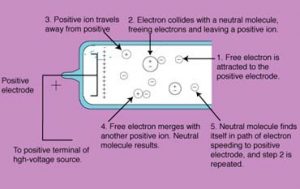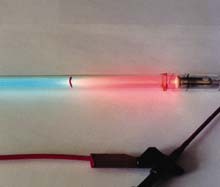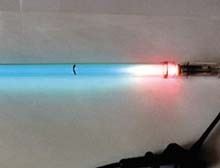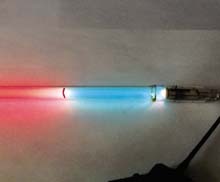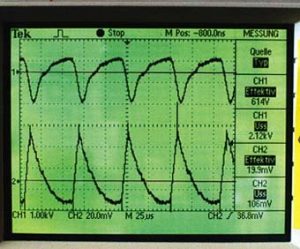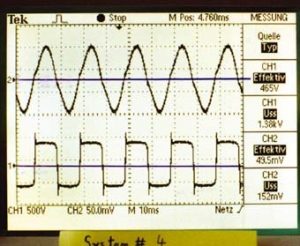This column is intended for experienced professionals interested in a neon tube’s physical and related phenomena. I’ll discuss some basic principles and how they apply to neon tubing. However, this theory doesn’t explain everything.
Neon tubes filled with argon/mercury can turn ugly and dim during severely cold weather (see ST, January 2002, page 40). But since the introduction of electronic power supplies nearly two decades ago, another phenomenon has plagued the use of these power supplies: mercury migration.
Fig. 1 depicts a sign suffering from mercury migration — the neon’s dimming begins at one end of the tube and, within time, extends toward the other electrode. Signs showing these symptoms are filled with argon/mercury, contain a high tube-length/diameter ratio and are operated by electronic power supplies. The tubes don’t reveal any staining; they’re not hot, and there’s no lack of mercury. Surprisingly, this symptom disappears quickly, once the tube is tested on an aging transformer.
Material-shift principle
The liquid mercury, affected by migration, is found only at one electrode, while the other electrode appears "dry." The mercury — which was distributed uniformly in the tube during manufacturing — has traveled to one side, hence the name of the phenomenon. A short physics review reveals what’s going on inside the operating neon tube shown in Fig. 2.
Basically, the tube contains neutral gas atoms and free electrons. First, the electrons are negatively charged and, thus, attracted by the positively charged electrode. This attraction accelerates the electrons, up to speeds of approximately 2.2 million miles per hour, until their path is obstructed by a gas atom.
Second, once the electron has gained enough speed (kinetic energy) before the collision, the electron will knock off one electron from the neutral gas atom, resulting in two free electrons.
The gas atom lacking one electron is no longer electrically neutral, but, because it’s lacking a negative electron charge, it’s charged positively. Atoms in this state are called ions.
Third, by being positively charged, the ion will be attracted by the negative electrode and move in the opposite direction from the electrons. The ion also will accelerate because of the negative electrode. But, because a typical neon ion is approximately 36,823 times heavier than one electron, it will gain much less speed before hitting another gas atom or electron.
Fourth, when the electron or ion is quite slow, the attractions of the positive-ion and negative-electron charges can lead to the electron being captured, resulting in a neutral gas atom again. The surplus energy is released in the form of ligh we use to make and operate neon tubes.
If these four processes are repeated, the electrons will travel from the negative electrode (not shown in Fig. 2) to the positive electrode, and the gas atoms, when ionized, will travel toward the negative electrode. The temporarily diminished amount of electrons at the tube ends is replenished by the external circuit via the electrodes, but the difference in gas atoms isn’t.
The speeds given aren’t average macroscopic values. To achieve a more precise theory, several other factors must be considered; the drift speeds over longer distances are much lower due to the additional statistical movement of electrons and atoms caused by thermal energy. Furthermore, the tubes aren’t only filled with pure mercury vapor (which, in our neon tubes, is in equilibrium with liquid mercury, and therefore, has to be considered a van der Waals gas, not an ideal gas), but also, with a backfilling gas like argon or argon/neon mixes. The backfilling gas is ionized by the electrons first, then, gas ions transfer their energy to the much heavier mercury atoms in what physicists call "collisions of the second kind."
A rough calculation from the specific conductivity of the plasma (300 MHO per meter) and the charge-carrier density (0.8 Coulombs per cubic meter) leads to average speeds of 13.5 thousand meters per second. (Note: These numbers are excerpted from M. v. Ardenne:"Tabellen zur Elektronenphysik, Ionenphysik und Elektronenmikroskopie," Deutscher Verlag der Wissenschaften, Berlin 1956.)
This average speed is superimposed to the thermal-diffusion drift speed. Fig. 3 shows a special tube I made for this purpose, filled with neon and a small amount of mercury. You’d expect that, when I operate this tube on direct current, all the mercury will be at the other end of the 20-in.-long tube in fractions of a second.
Thermal diffusion always tries to equalize pressure differences and so poses a counterforce; thus, the tube must operate continually at approximately 3.5mA of DC to keep the border between red and blue at the mark. With 20mA of DC applied, the whole amount of mercury can be shifted from one end of the tube to the other end in roughly 17 minutes.
In a neon sign, gas atoms can’t be shifted to only one side of the tube, because we’re operating our tubes with alternating current, so the polarity is reversed 120 times a second when the sign is operated on a magnetic transformer. Thus, the gas and mercury are shifted back and forth 120 times a second.
In the short time of one half-cycle, 8.3 milliseconds, a gas atom will travel roughly 3,375 ft. (1,125 meters)– much more than the dimension of our neon tube. In fact, they’re swinging so far that they’ll slam into the other tube end within every half-cycle. (Note: This calculation is correct only on a microscopic scale. Other effects also take place because the initial aging process in tube fabrication takes minutes to hours to distribute the mercury throughout the tube.)
Now, let’s examine the difference when we operate the neon tube on an electronic transformer with alternating current containing a much higher frequency. A typical frequency is 45 kilocycles, which leads to a half-cycle time of 11 microseconds. In this short time, our "average" gas atom will travel the path of 5 ft., or 1.5 meters, which is less than a standard tube length.
Asymmetric waveform
If the atoms would travel exactly the same way, back and forth, every time, they would travel a short path without problems during every half-cycle. However, imagine the travel distances in one direction being slightly larger (the proverbial three steps forward and two steps back). In this case, the atoms will travel back and forth, but they’ll yield a total movement in one single direction over time — they’ll migrate. But how does this happen?
Electronic power supplies generate the high frequency by an electronic oscillator, and the waveform depends on many factors in the circuit dimensioning. It’s quite difficult to obtain a completely symmetric waveform like that shown in Fig. 4, and, in most cases, you’ll end up with a more or less asymmetric waveform like that in Fig. 5. Here, the voltage applied in one direction (and thus, the speed of the gas atoms) is much higher than in the other.
Sign-service people cure signs suffering mercury migration by simply switching over both leads going from the electronic transformer to the tubes. This causes a change of the average movement into the opposite direction, but it will never be a total remedy. The migration will show up again in the other direction after time.
Instead, replace the power supply with one having the exact symmetrical waveform, or even better, use magnetic transformers, which push the mercury atoms through the entire tube every cycle, smashing them into the opposite electrode.



 Tip Sheet1 week ago
Tip Sheet1 week ago
 Photo Gallery2 days ago
Photo Gallery2 days ago
 Ask Signs of the Times4 days ago
Ask Signs of the Times4 days ago
 Real Deal1 week ago
Real Deal1 week ago
 Benchmarks6 days ago
Benchmarks6 days ago
 Women in Signs1 week ago
Women in Signs1 week ago
 Photo Gallery1 week ago
Photo Gallery1 week ago
 Women in Signs1 week ago
Women in Signs1 week ago
